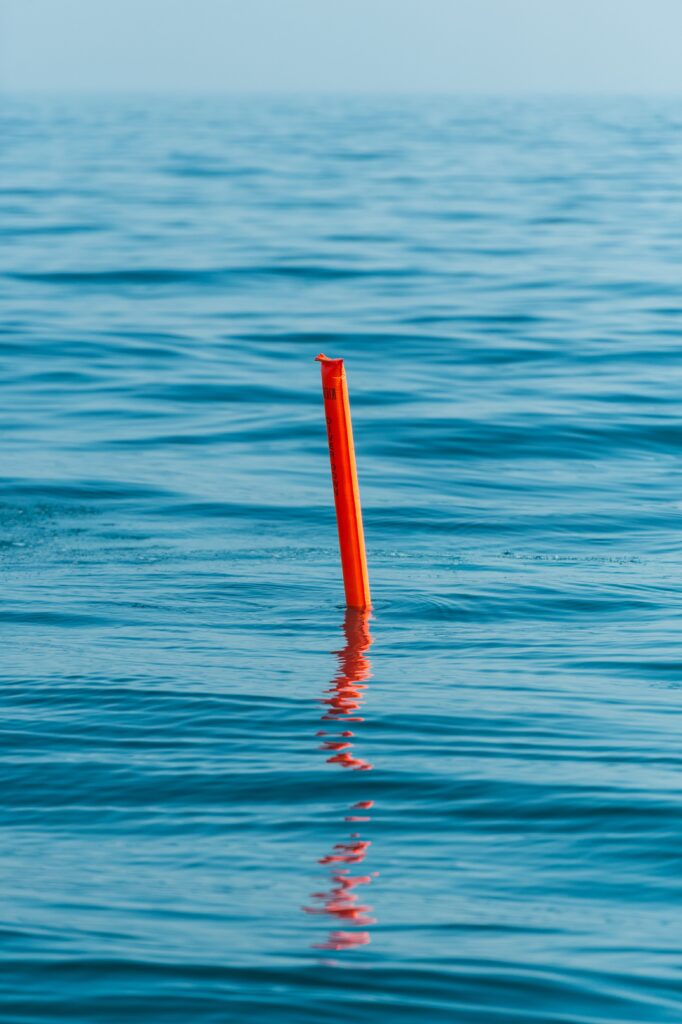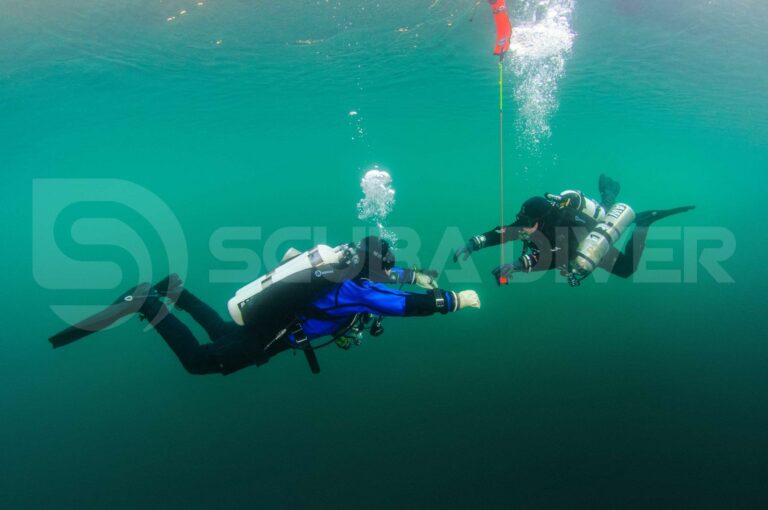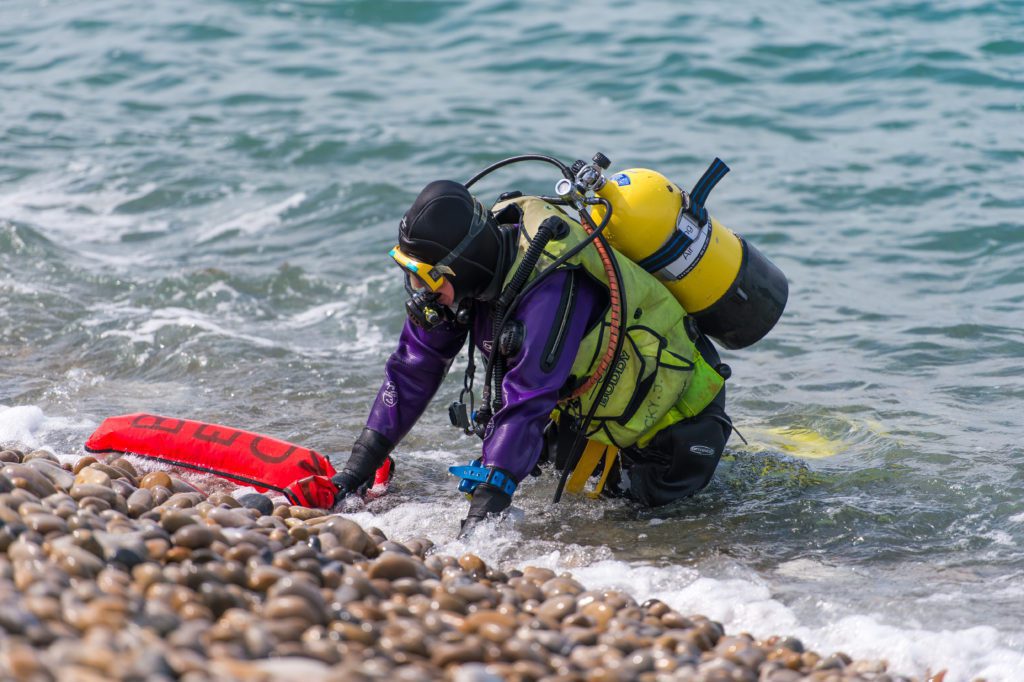The delayed surface marker buoy is an invaluable item of diver equipment – here industry experts look at choosing the best for you and the various ways of using it – taking into consideration, of course, the thorny issue of reels v spools
Also read: Dive Like A Pro: Hardboat diving
Delayed surface marker buoys are among the most essential pieces of dive-safety kit to be found in a diver’s arsenal. The ability to notify the surface of your location when you are still deep under water is paramount, so all divers should carry – and know how to deploy – a DSMB. Whichever type you choose, make sure to carry it with you on every dive.
Key skills
Mark Powell, TDI/SDI Business Development Manager: “The ability to send up a DSMB is one of the key skills for any diver. There are a number of styles, each with their own strengths and weaknesses. The traditional marker buoy with an opening at the bottom that is inflated by purging the regulator or exhaled gas is still very common, and the simplicity of the design has many supporters. However, there are a number of alternatives.
“The most common is a buoy with a small gas cylinder attached. The cylinder is used to inflate the buoy, which is intended to simplify the overall process. The diver just ‘cracks’ the bottle and the buoy inflates. This saves the effort of having to fill it manually. and when it works correctly is definitely easier.
“Among rebreather divers these are very popular, because filling a conventional open-ended DSMB is much more complicated for them. There is no exhaled gas to fill the cylinder and the smaller size of the diluent cylinders makes purging a regulator to fill the DSMB a much less attractive solution.
“However, many divers are of the opinion that if you struggle to fill a DSMB without a crack-bottle, it would be better to practise your technique a bit more. It is also amusing to watch divers trying to fill a DSMB at the end of a dive after they realise that they forgot to fill the crack-bottle.
“There is also a dive safety concern with these bottles. They are rarely tested in the same way as regular cylinders, because they are filled from another cylinder so there is no dive-shop to enforce testing. However, they are often very corroded, because they get water contamination inside.
“Combined with the fact that many divers purge the connector on them by hitting it with a lump of lead, you can see that care should be taken with them.
Low-pressure inflator
“Another option is to have a low-pressure inflator on the DSMB, similar to the inflator on your drysuit or wing. To use this system, the diver disconnects their drysuit inflator and uses it to inflate the DSMB.
“At first most divers are wary of this idea because they think there is a risk of the inflator becoming jammed onto the DSMB and pulling them up to the surface. In reality this isn’t a problem because the inflator, unlike the one on the suit, has no locking groove and so the DSMB just pulls off when full.
“Like many things, it’s a case of practice. After a few practice attempts, the whole process is very easy. This style of DSMB is ideal for rebreather divers because it doesn’t involve removing or purging a regulator or the use of exhaled gas.”

“When it comes to DSMBs, size really does matter. Smaller ones are fine for practice or as a back-up, but for long decompression stops in the open sea, a boat skipper is not going to appreciate having to keep an eye on one of these small DSMBs. A larger one will be much easier for a skipper to spot and keep an eye on.
“Besides the DSMB, there are different options for the reel. The main choice is between a reel and a spool. A spool is just a drum of steel or plastics onto which line can be wrapped. They evolved from overhead-environment diving such as cave-diving or wreck-penetration, where they are used to ‘jump’ from one guideline to another, or in the case of losing the guideline.
“As such they are much simpler than a reel. There is no handle, frame or ratchet and so they are also much smaller. This is an advantage because they don’t take up much room and can be stored in pockets.
“Reels, on the other hand, tend to be considerably bigger. There are some that are designed to be more compact and can fit in a pocket but many are too big, especially if you are also carrying a back-up reel.
“The other differences between different types of reels and spools are the length of line that they contain. This is particularly relevant for deeper divers, because if the reel or spool contains less line than the depth at which you are diving, it will be impossible to send it up from the bottom.
Using reels and spools
“The techniques for using reels and spools are quite different and, where technique differs, there will inevitably be differences of opinion as to which is best. Supporters of reels claim that spools are fiddly, difficult to use, prone to error and likely to cause problems. On the other hand, spool supporters claim that reels are fiddly, difficult to use, prone to error and likely to cause problems!
“Much of this disagreement stems from familiarity with one approach and the typically human reaction to change. If you have spent years using a reel and have perfected the technique, then trying to use a spool is going to cause problems. The technique you are used to is no longer applicable, you experience problems you never had before and struggle to perform what would otherwise have been an easy operation with your familiar equipment.
“So it’s no wonder that long-time reel users when using a spool for the first time will struggle, and many will simply give up and return to what they know.
“The reverse situation can also occur, although that is less common. Deeper divers first learn to use a reel and then later come across the idea of a spool. However, there are divers that primarily use a spool and have little or no experience of reels. For them, trying to use a reel results in the same situation, they are unfamiliar with it, do not know the right technique and are likely to make mistakes.
“If they have poor technique with a reel, they are likely to prefer to revert to using the more familiar spool. It’s a shame that there is this split between reels and spools, because each has its own advantages.
“My own preference is to use a reliable reel with 65m of line and a large DSMB as my primary, and then use a spool with 30m of line and a smaller DSMB as my back-up. The simplicity and reliability of my primary reel removes one potential source of stress during the ascent and the size of the DSMB makes it easy for the skipper to keep track of me.
“Then the compactness and simplicity of the spool is ideal for a back-up, and the small DSMB is already attached to the reel and can be sent up quickly if required. This is an ideal set-up for me and is becoming more common.
“However, it is interesting to see how many people adopt this approach but have never practised sending up the back-up DSMB using the spool. The worst time to practise the correct technique is just after your primary reel has jammed and shot to the surface.
“So my advice would be that if you have a spool as a back-up, use it occasionally instead of your primary so that when you need to use it for real, you are just as familiar with the spool as with your reel.
“Whichever method you choose to use, it‘s worth trying others. If you have to send up your buddy’s DSMB, it’s worth knowing how their style works, how the SMB is inflated and how the reel or spool is operated.
“In addition, it’s important to be able to practise sending up your DSMB while neutrally buoyant and in midwater. If there is a problem with your main SMB, you might need to send one up partway through the ascent, and if you know you can do this easily while maintaining your buoyancy, it will significantly reduce the stress of the situation.
“In addition to a primary DSMB and a back-up, some technical divers also carry a third, emergency DSMB. While the primary and back-up are orange, the emergency DSMB is yellow. This is used to indicate that there is a problem or that the divers may need more gas.
“The use of a yellow DSMB as an emergency signal is becoming more common, with some inland sites treating any yellow DSMB as an emergency signal.
The British Diving Safety Group (BDSG) recommends that recreational divers use an orange DSMB rather than a yellow one to avoid confusion.The yellow emergency DSMB is usually just clipped onto the same line as the already-deployed main DSMB, inflated and sent up the same line. In this case, the skipper will see a normal orange blob as well as the yellow blob on the same line.
“It is also common to attach a slate or waterproof notebook to the top of the DSMB to tell the skipper what the problem is. A yellow DSMB is only of use if you have agreed the protocol with the skipper and have suitable gas available, rigged up ready to be dropped down to a diver. It should not be considered as a ‘get out of jail free’ card.
Maintaining safety
Garry Dallas, Director of Training for RAID UK & Malta: “How many of you would drive your car an epic distance without a spare wheel on board? Even if you had that spare wheel, would you know how to fit it?
“Whether you call them blobs, markers, tubes, SMBs or DSMBs, they are tools to provide you with the element of safety, not only under water but also above. There are many uses for these tools, and every single diver should own and know how to use one, without question.
“So you might think there’s a good reason not to need one – because my best buddy I always dive with has one… and that’s exactly the mentality that could get you into difficulty if you get separated. Times have changed and it’s time to think about being safer and enjoy every dive. On every RAID training dive we practise deployment.
“Yes, DSMBs come in all shapes and sizes, but choose the one that suits your environment: orange/black, orange and black, pink (for the well-used ones) or yellow for emergencies only.
“There are also various methods for inflating them – oral, low-pressure inflator attachment, open-ended, crack-bottle or disposable canister – and these can be used to ensure that they are nice and erect on the surface. Each to their own, but there are always pros and cons for each, so get good experienced advice before purchasing one.
“As a cave-diver, my preference is for spools. They are simple to use and give more control of the line. Coldwater spools, with larger finger-holes, are best all round (haha) for every environment.
“Reels should be compact and sturdy. Cheaply made plastic ratchets crack and break – definitely not the ideal situation to be in as you’re releasing the DSMB. Because braided line stretches during use, over-spooling of the line is also a common problem.
“So soak your line in water and reel out the entire length around a couple of posts. Then check that the end of the line is secure around the spindle and reel it back in firmly and evenly across the spindle. Finishing off the loose end is a requirement for a specific use, but usually a large aperture loop is best.
“Again, each to their own, reel or spool. No matter which type you choose, mastering using it is of paramount importance. Here’s a useful video link for deploying a DSMB.
Sea survival training
Emily Petley-Jones, PADI Regional Training Consultant: “DSMBs and reels are essential pieces of kit for diving, particularly in choppier seas and if diving from a boat. For your marker buoy, size really does matter.
“The question you should always ask yourself is: ‘Which one will be the most visible?’. If you are a UK diver, you might wish to consider taking the RNLI Diver Sea Survival course, which is available as a PADI speciality. This contains some hugely useful information, and brings home the message about the importance of staying visible at the surface.
“You should always check your DSMB and reel before every dive, even if you are not planning on using it. You should ensure that the line on the reel will feed out smoothly and not snag.
“A good way to get your reel set properly is to unravel it, then secure the end of the line to something sturdy and keep tension on the line as you reel it back in. You should also ensure that the line is long enough for the depth of the dive.
“Putting up a DSMB takes practice, so if you have a new DSMB and reel take it to the pool or shallow water to ensure that you get your technique sorted and don’t end up fumbling with it at 20m, ideally wearing the same gloves that you might be using on the dive.
“Don’t forget, there are also courses that will help you to learn this skill, such as the PADI Delayed Surface Marker Buoy speciality.”
Jason Sockett, PADI Quality Management Consultant: “DSMBs and reels I believe are among the most under-estimated pieces of kit to be purchased, especially for divers early on in their underwater adventures, but it’s important to get the correct type for the diving you’re doing.
“I never dive without a DSMB and reel. It’s reassuring to know that on my ascent, especially on a drift-dive when there are other boats in the area or when the conditions are far from perfect, the boat captain(s) can see where I am.
“If I have one piece of advice to offer with using DSMB and reel, it’s this: practise, practise and practise. Try to get to the stage where you can deploy your DSMB almost without thinking – and especially without any buoyancy issues.”
BDSG recommendations
Divers using surface marker buoys should clearly label them with the full name of their owners. Avoid nicknames, because these might not be known to the dive-marshal.
If using the DSMB for decompression, the buoy should be clearly marked with the words ‘Decompression’ in addition to the diver’s name.
To avoid confusion, the colour of a single DSMB should be orange or red, but not yellow. When carrying two DSMBs on a dive, the general European consensus is that an orange or red buoy is deployed under normal diving conditions. In an emergency, or when assistance is required, a yellow buoy should be deployed. When using a yellow buoy, clearly mark on the buoy the word ‘Emergency’ with the diver’s name.
Once a yellow buoy is seen the support team and or boat can then initiate the standard emergency protocols depending on the situation.
Also on Divernet: Which Safety Gear To Carry, Buying Your Own Gear, Packing Gear For A Dive Trip, What To Check Before Diving, Night Diving, Developing Core Skills, Coldwater Diving, Caring For Diving Equipment, Calling A Dive





Nice article but as a diver cox’n and instructor I prefer to use a yellow DSMB when it’s raining, at night or when it’s dull and overcast as they are easier to spot and follow.
The dive community is trying hard to set a standard protocol for emergencies. Making up your own ideas doesn’t help. Use Yellow for emergencies.